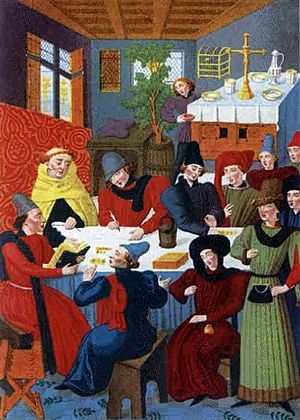Payment facts for kids
A payment is when something valuable, like money, is given from one person or group to another. For example, when you buy a new video game, you make a payment to the store. Payments are usually made when you receive goods (like a toy or a book) or services (like a haircut or a bus ride).
How Payments Started: Barter
The very first way people made payments was through something called barter. Barter is a simple trade where people exchange one good or service directly for another without using money. For example, someone might trade their extra apples for a neighbor's fresh bread. This was common long before money was invented.
Modern Ways to Pay
Today, most payments involve money or other modern methods. Here are some common ways people pay for things:
- Cash: Using physical coins and paper money.
- Cheques: A written order telling a bank to pay a certain amount of money from your account to someone else.
- Debit Cards: These cards take money directly from your bank account when you make a purchase.
- Credit Cards: These cards let you buy things now and pay for them later. It's like borrowing money from the bank for a short time.
- Bank Transfers: Sending money directly from one bank account to another, often done online.
- Mobile Payments: Using your smartphone or other mobile device to pay, often through apps or digital wallets.
Who Pays and Who Gets Paid?
In the world of payments, there are two main roles:
- The payer is the person or group who sends the payment.
- The payee is the person or group who receives the payment.
For example, if you buy a snack at the store, you are the payer, and the store is the payee.
See also
 In Spanish: Pago para niños
In Spanish: Pago para niños


